A well-structured baseball weight training program enhances strength‚ power‚ and endurance‚ while reducing injury risks․ It focuses on building muscle groups essential for hitting‚ pitching‚ and fielding‚ ensuring optimal performance on the field․
1․1 Importance of Strength Training in Baseball
Strength training is a cornerstone of baseball performance‚ playing a pivotal role in enhancing power‚ speed‚ and endurance․ It helps athletes develop the muscular strength needed for explosive movements‚ such as swinging a bat or throwing a pitch․ A well-designed strength program improves overall athleticism‚ enabling players to maintain peak performance throughout the season․ Additionally‚ it reduces the risk of injuries by strengthening muscles and connective tissues‚ which are subjected to repetitive stress in baseball․ Strengthening the upper body enhances hitting and throwing power‚ while lower body strength improves speed and stability․ Core strength is equally critical‚ as it provides the foundation for all baseball movements․ Without a structured strength program‚ players may struggle with consistency and durability‚ especially during the grind of a long season․ Thus‚ strength training is essential for optimizing performance‚ preventing injuries‚ and achieving long-term success in baseball․
1․2 Benefits of a Structured Weight Training Program
A structured weight training program offers numerous benefits tailored to the demands of baseball․ It enhances overall muscle balance‚ reducing the risk of injuries by strengthening key areas like the shoulders‚ elbows‚ and knees․ Such a program improves power output‚ enabling hitters to generate more bat speed and pitchers to increase velocity․ It also boosts endurance‚ allowing players to maintain performance levels throughout the game and over the course of a long season․ A well-organized training plan ensures that each workout is purposeful‚ targeting specific muscle groups and movement patterns relevant to baseball․ This approach not only maximizes gains but also prevents overtraining․ Additionally‚ a structured program fosters consistency and accountability‚ which are crucial for long-term progress․ By addressing strength‚ power‚ and endurance comprehensively‚ a structured weight training program prepares players to excel in all aspects of the game‚ from hitting and pitching to fielding and baserunning․

Components of a Baseball Weight Training Program
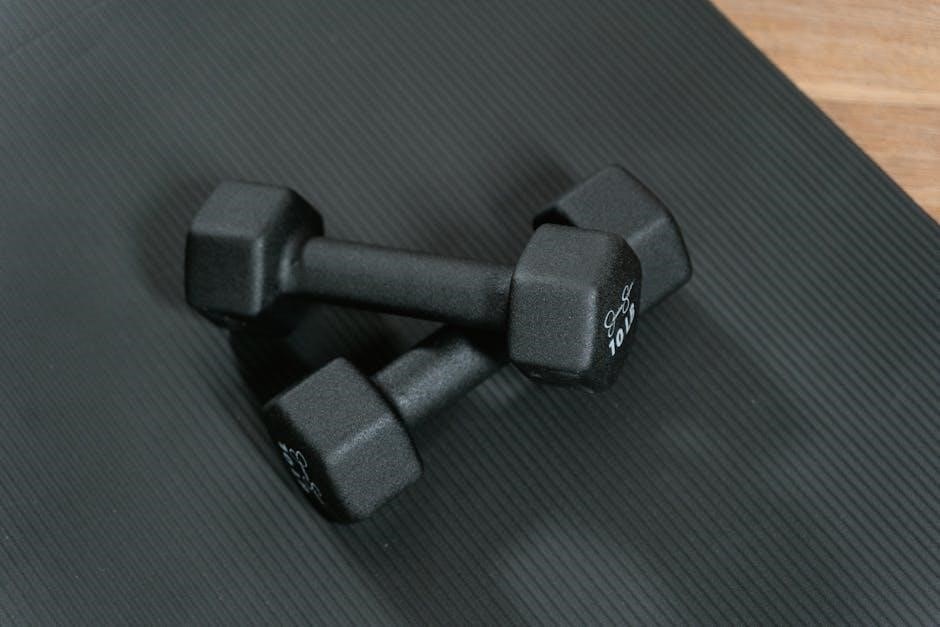
A comprehensive baseball weight training program includes upper body strength‚ lower body power‚ core stability‚ and injury prevention exercises․ These components work together to enhance performance and durability for the demands of the sport․

2․1 Upper Body Strength Development
Upper body strength is crucial for baseball players to enhance hitting‚ pitching‚ and throwing performance․ A well-designed program focuses on building shoulder‚ chest‚ and tricep strength‚ which are essential for generating power and endurance․ Exercises like bench presses‚ pull-ups‚ and shoulder presses target these muscle groups‚ improving overall stability and durability․ Incorporating compound movements ensures functional strength that translates directly to the field․ Additionally‚ exercises like rows and lateral raises help maintain shoulder health‚ reducing the risk of injuries common in baseball․ A structured upper body routine not only boosts performance but also supports overall athleticism‚ enabling players to maintain consistency throughout the season․ By prioritizing upper body development‚ players can achieve a balanced physique that supports both offensive and defensive skills‚ ensuring they remain competitive and resilient in every game․
2․2 Lower Body Power and Explosiveness
Developing lower body power and explosiveness is vital for baseball players‚ as it directly impacts speed‚ acceleration‚ and the ability to generate force during actions like sprinting and jumping․ A well-structured weight training program focuses on exercises that target the legs‚ glutes‚ and hips‚ such as squats‚ deadlifts‚ and lunges․ These movements build the strength and power needed for explosive movements on the field․ Additionally‚ plyometric exercises like box jumps and depth jumps enhance fast-twitch muscle fibers‚ improving quick bursts of speed and agility․ Strengthening the lower body also enhances stability and balance‚ which are critical for maintaining proper form during dynamic movements․ By incorporating these exercises into a training routine‚ players can improve their overall performance‚ enabling them to run faster‚ jump higher‚ and react more quickly to the demands of the game․ A strong lower body foundation is essential for achieving peak athleticism in baseball․
2․3 Core Stability and Functional Strength
Core stability and functional strength are critical components of a baseball weight training program‚ as they enhance a player’s ability to generate power‚ maintain proper posture‚ and transfer force efficiently during movements․ The core muscles‚ including the abdominals‚ obliques‚ and lower back‚ act as the body’s foundation‚ enabling actions like throwing‚ hitting‚ and fielding․ Functional strength exercises‚ such as planks‚ rotational movements‚ and medicine ball throws‚ mimic the dynamic nature of baseball‚ improving coordination and balance․ Strengthening the core also reduces the risk of injuries by stabilizing the spine and improving overall athleticism․ By incorporating exercises that target these areas‚ players can achieve better control over their bodies‚ leading to more precise and powerful performances on the field․ A strong and stable core is essential for maximizing potential in all aspects of the game․
2․4 Injury Prevention Through Targeted Exercises
Injury prevention is a cornerstone of any effective baseball weight training program‚ ensuring longevity and consistency in performance․ Targeted exercises focus on strengthening vulnerable areas‚ such as the shoulders‚ elbows‚ and knees‚ which are prone to overuse and stress in baseball․ By improving joint stability‚ muscle balance‚ and flexibility‚ these exercises reduce the risk of common injuries like pitcher’s elbow‚ rotator cuff strains‚ and hamstring pulls․ Incorporating exercises like rotator cuff stabilization‚ scapular strength work‚ and hip mobility drills helps maintain proper movement patterns and absorbs repetitive stresses․ A well-designed program also addresses muscle imbalances‚ ensuring that no single muscle group is overworked․ This proactive approach not only prevents injuries but also enhances overall resilience‚ allowing players to perform at their best throughout the season․ Prioritizing injury prevention ensures that athletes can train consistently and maintain peak performance without setbacks․
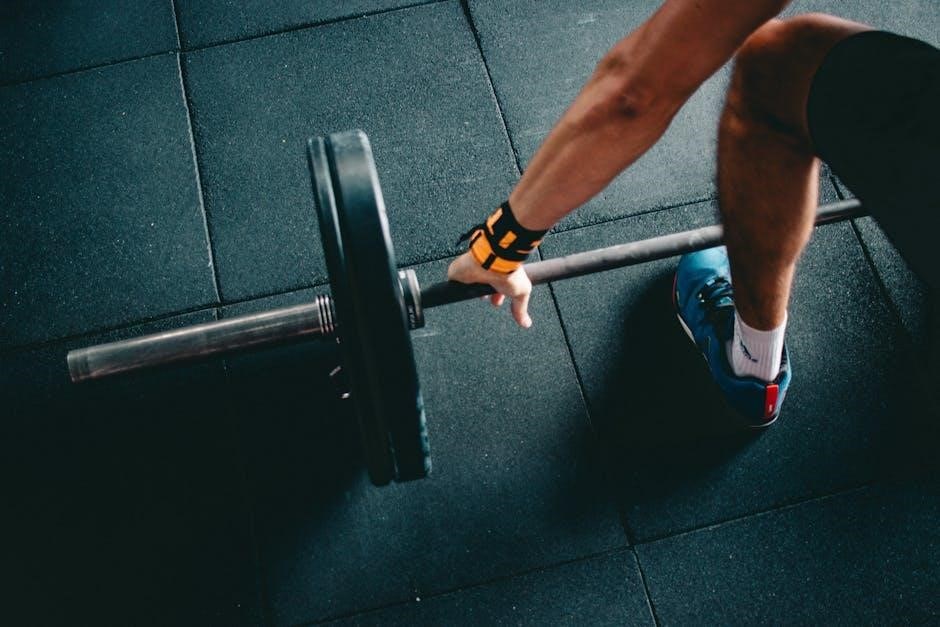
Specific Workouts for Baseball Players
- Hitting Workout: Focuses on building power and endurance for optimal swing performance․
- Pitching Workout: Strengthens shoulders and core for durability and velocity․
- Speed and Agility Training: Enhances quickness and reaction time for faster base running․
- Power Workout: Develops explosive strength for hitting and throwing․
- Fielding Workout: Improves agility and reaction for sharper fielding skills․
3․1 Hitting Workout: Building Power and Endurance
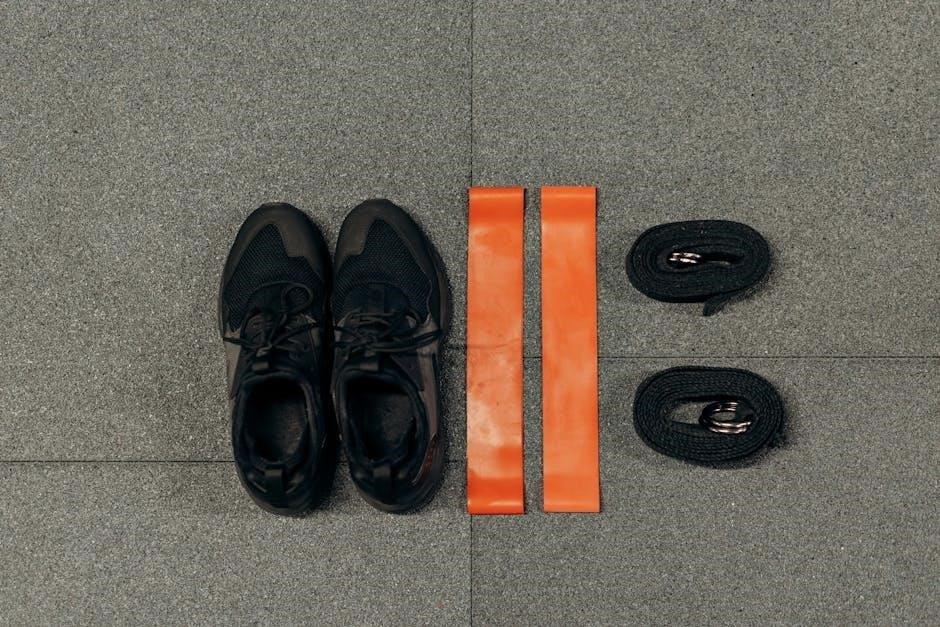
A hitting workout is designed to enhance a player’s ability to generate power and maintain endurance throughout a game․ This is achieved through a combination of strength training and sport-specific exercises․ Key components include medicine ball swings to improve rotational power‚ weighted bat swings to build bat speed‚ and plyometric exercises to increase explosiveness․ Resistance band work targets the shoulders and arms‚ crucial for maintaining swing mechanics over multiple at-bats․ Additionally‚ core-strengthening exercises like plank variations and Russian twists are essential‚ as a strong core stabilizes the body during the swing․ Endurance is developed through high-repetition drills‚ ensuring players can perform at peak levels late in the game․ These workouts are tailored to mimic the physical demands of hitting‚ helping players achieve consistent and powerful performance at the plate․
3․2 Pitching Workout: Strength and Durability
A pitching workout is tailored to build the strength and durability needed for repetitive throwing motions․ This program focuses on exercises that enhance shoulder stability‚ core strength‚ and leg power‚ all critical for velocity and control․ Key exercises include medicine ball throws to improve explosive power‚ pull-ups and dumbbell rows to strengthen the upper back and shoulders‚ and weighted plyometric drills to simulate pitching mechanics․ Leg workouts‚ such as squats and lunges‚ are emphasized to generate power from the lower half․ Core exercises like planks and rotational movements help maintain stability and prevent fatigue․ Additionally‚ injury prevention is a priority‚ with exercises targeting the rotator cuff and scapular muscles to reduce the risk of common pitching injuries․ By combining these elements‚ pitchers can improve their endurance‚ maintain consistent performance‚ and minimize the risk of overuse injuries throughout the season․
3․3 Speed and Agility Training
Speed and agility training is essential for baseball players to excel on the field‚ enhancing their ability to run the bases‚ track fly balls‚ and react quickly to plays․ This component focuses on exercises that improve acceleration‚ deceleration‚ and directional changes․ Sprint drills‚ such as 20-yard dashes and shuttle runs‚ are used to build explosive speed and endurance․ Agility ladder exercises and cone drills are incorporated to refine footwork‚ balance‚ and coordination․ Plyometric workouts‚ including box jumps and burpees‚ add explosiveness to movements․ These exercises simulate game-like scenarios‚ helping players develop the quickness and reaction time needed for fast-paced plays․ By integrating speed and agility training into the overall program‚ players can improve their performance‚ gain a competitive edge‚ and reduce the risk of injuries associated with sudden stops and changes in direction;
3․4 Power Workout: Explosive Movements
A power workout focuses on explosive movements that enhance a baseball player’s ability to generate force quickly‚ which is critical for hitting‚ pitching‚ and fielding․ This component of the training program includes exercises such as box jumps‚ medicine ball throws‚ and plyometric movements to improve power output․ Weighted sled pushes and resistance band drills are also incorporated to build leg strength and acceleration․ These exercises mimic the explosive actions seen in baseball‚ such as swinging a bat or throwing a pitch․ By targeting fast-twitch muscle fibers‚ players can increase their power and speed․ The power workout is typically performed 2-3 times per week‚ with a focus on maximum effort and proper form․ Progressive overload is applied by increasing weights or resistance over time to continue building strength and explosiveness․ This workout is essential for improving performance in game-specific situations‚ such as hitting home runs or making quick throws from the outfield․
3․5 Fielding Workout: Agility and Reaction
The fielding workout is designed to enhance agility‚ reaction time‚ and functional strength‚ all of which are crucial for making quick‚ precise plays on the field․ This workout includes drills such as ladder drills‚ cone exercises‚ and reaction ball training to improve footwork and coordination․ Players also engage in exercises like shuttle runs and lateral movement drills to simulate the rapid changes of direction required during fielding․ Reaction training involves tasks like catching batted balls or reacting to grounders‚ helping players develop instincts and quick decision-making․ Strength exercises‚ such as resistance band work and medicine ball tosses‚ are incorporated to build the functional strength needed for throwing and fielding with accuracy․ By combining agility‚ reaction‚ and strength training‚ this workout prepares players to handle the demands of fielding at a high level‚ ensuring they can make sharp cuts‚ quick throws‚ and instinctive plays during games․
3․6 Quickness Drills for Faster Performance
Quickness drills are essential for baseball players to enhance their speed‚ acceleration‚ and reaction time․ These exercises focus on improving first-step explosiveness‚ which is critical for reacting to the ball‚ rounding bases‚ and chasing down fly balls․ Ladder drills‚ such as high knees‚ lateral shuffles‚ and carioca drills‚ are commonly used to boost foot speed and agility․ Cone exercises‚ like zigzag runs and figure-eight patterns‚ simulate game-like movements‚ helping players change direction rapidly․ Reaction ball training and box jumps are also incorporated to improve burst speed and power․ Additionally‚ shuttle runs and resisted sprints with bands or weights can enhance lower body strength and acceleration․ These drills are designed to mimic the fast-paced nature of baseball‚ ensuring players can react swiftly and move efficiently during games․ By consistently practicing these quickness drills‚ players can gain a competitive edge in their performance on the field․

Additional Training Elements
Additional training elements include agility drills‚ plyometric exercises‚ and reaction training to enhance speed and explosiveness․ These components complement strength training‚ ensuring a well-rounded approach to improving baseball performance and reducing injury risks․
4․1 Conditioning Workouts for Endurance
Conditioning workouts are essential for building endurance in baseball‚ enabling players to maintain peak performance throughout the game․ These workouts typically include a mix of cardiovascular exercises‚ such as sprint intervals‚ distance running‚ and high-intensity interval training (HIIT)․ The goal is to improve stamina and increase the body’s ability to recover between plays․ Many programs incorporate agility drills and strength training to enhance overall endurance․ For example‚ a common approach is to combine short bursts of intense activity with periods of rest to mimic the demands of a baseball game․ Additionally‚ flexibility and mobility routines are often integrated to prevent fatigue-related injuries․ Consistency in conditioning is crucial‚ as it directly impacts a player’s ability to perform at their best during the entire season․ Proper hydration‚ nutrition‚ and recovery strategies are also emphasized to support the body during intense training․ A well-structured conditioning program ensures that players are prepared for the physical and mental demands of the sport․
4․2 Flexibility and Mobility Routines
Flexibility and mobility routines are critical components of a comprehensive baseball weight training program․ These exercises focus on improving range of motion‚ reducing muscle stiffness‚ and enhancing movement efficiency․ By incorporating dynamic stretching‚ static stretching‚ and mobility drills‚ players can maintain optimal flexibility‚ which is essential for explosive movements like swinging a bat or throwing a pitch․ Dynamic stretches‚ such as arm circles and leg swings‚ are particularly effective before practices and games to prepare the body for action․ Static stretches‚ like hamstring and shoulder stretches‚ are often performed after workouts to promote recovery and prevent tightness․ Additionally‚ mobility exercises targeting the hips‚ thoracic spine‚ and ankles can improve a player’s ability to move fluidly and generate power․ Including yoga or foam rolling in the routine can further enhance flexibility and reduce muscle soreness․ Consistent flexibility and mobility work not only supports performance but also helps prevent injuries‚ making it a cornerstone of any successful baseball training program․
4․3 Nutrition and Recovery Strategies
Nutrition and recovery are vital for optimizing performance in a baseball weight training program․ A balanced diet rich in protein‚ complex carbohydrates‚ and healthy fats fuels muscle growth and energy needs․ Proper hydration is essential to maintain performance and prevent fatigue․ Post-workout nutrition‚ including protein shakes or meals‚ aids in muscle recovery and repair․ Additionally‚ adequate sleep and rest are critical for physical recovery‚ allowing muscles to rebuild and strengthen․ Recovery strategies such as foam rolling‚ ice baths‚ and stretching can reduce muscle soreness and improve flexibility․ A well-planned nutrition and recovery plan ensures players can train consistently‚ avoid injuries‚ and perform at their best during games․ By prioritizing these elements‚ baseball athletes can enhance their overall training outcomes and maintain peak physical condition throughout the season․
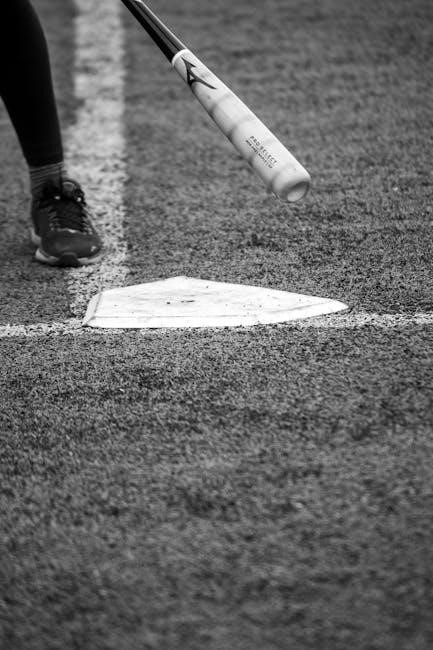
Sample 6-Week Training Routine
This structured 6-week program focuses on progressive overload‚ balancing strength‚ power‚ and conditioning․ Each week builds on the previous‚ incorporating specific exercises to enhance baseball performance while allowing for recovery and mobility․
5․1 Weekly Workout Structure
A well-organized weekly workout structure is key to achieving peak performance in baseball․ The program typically consists of 3-4 lifting days‚ with each session targeting specific muscle groups․ For example‚ Day 1 might focus on Upper Body Strength‚ including exercises like bench presses and pull-ups․ Day 2 could emphasize Lower Body Power‚ incorporating squats and deadlifts to build explosiveness․ Day 3 might center on Core Stability‚ with planks and rotational exercises to improve functional strength․ Conditioning and agility drills are often integrated on separate days to enhance endurance and quickness․ Rest days are strategically placed to allow for recovery and muscle growth․ The structure ensures a balanced approach‚ avoiding overtraining while addressing all aspects of baseball performance․ This routine is tailored to progressively increase intensity‚ helping athletes build strength‚ power‚ and endurance over the 6-week period․
5․2 Progressive Overload Strategy
Progressive overload is a cornerstone of effective baseball weight training‚ ensuring continuous strength and power gains․ This strategy involves gradually increasing the intensity of workouts over time․ One common method is adding weight or resistance to exercises weekly; For instance‚ if an athlete bench presses 200 lbs in Week 1‚ they aim to lift 205 lbs by Week 2․ Another approach is increasing the number of repetitions or sets․ For example‚ moving from 3 sets of 8 reps to 4 sets of 8 reps․ Additionally‚ decreasing rest time between sets or incorporating more challenging variations of exercises can enhance intensity․ The goal is to challenge muscles progressively‚ preventing plateaus and fostering consistent improvement․ This systematic approach ensures athletes build the strength and power needed for peak baseball performance‚ aligning with the overall program’s objectives of enhancing speed‚ agility‚ and endurance while minimizing injury risks․ Consistency in applying progressive overload is vital for long-term success․
5․3 In-Season Maintenance Program

Maintaining strength and endurance during the baseball season is crucial for sustained performance․ The in-season maintenance program focuses on preserving gains made in the off-season while avoiding overtraining․ It typically involves reduced intensity and volume‚ with an emphasis on functional exercises that align with baseball-specific movements․ Light upper body workouts‚ lower body power maintenance‚ and core stability exercises are prioritized to ensure players remain strong without fatiguing their muscles․ Conditioning drills are tailored to maintain speed and agility without excessive strain․ The program also incorporates active recovery techniques‚ such as light cardio and mobility work‚ to aid in muscle repair․ By balancing strength maintenance with in-game demands‚ players can avoid performance decline and injury risks․ This structured approach ensures athletes stay physically prepared throughout the season‚ supporting both individual and team success․ The goal is to sustain peak performance while preserving energy for the competitive schedule ahead․
A well-designed baseball weight training program enhances performance‚ builds strength‚ and prevents injuries․ Consistency and proper execution are key to achieving long-term success and sustained athletic excellence on the field․
6․1 Consistency and Dedication in Training
Consistency and dedication are the cornerstones of a successful baseball weight training program․ Players must commit to regular workouts‚ ensuring that strength and endurance are built progressively; A well-structured schedule helps maintain focus and prevents overtraining․ Dedication to the program translates into improved performance‚ as consistent effort fosters muscle memory and skill enhancement․ Mental toughness also plays a crucial role‚ as staying motivated during challenging sessions is essential for long-term success․ Without consistent effort‚ gains in strength and power may plateau‚ hindering overall progress․ Coaches and athletes alike must emphasize the importance of adhering to the training plan‚ even during off-seasons or when motivation wanes․ By staying committed‚ players can achieve their goals and elevate their game to the next level․
- Regular workouts build strength and endurance․
- Dedication enhances skill and mental toughness․
- Consistency prevents plateaus and ensures progress․
Ultimately‚ consistency and dedication are vital for maximizing the benefits of a baseball weight training program and achieving success on the field․
6․2 Measuring Progress and Adjusting the Program
Measuring progress and adjusting the training program are essential for ensuring continued improvement in baseball weight training․ Regular strength assessments‚ performance metrics‚ and coach feedback help track advancements․ Players should monitor increases in lift weights‚ repetitions‚ and overall endurance․ If progress stalls‚ the program may need adjustment‚ such as introducing new exercises or increasing intensity․ Adjustments should also consider individual goals‚ injuries‚ or changes in the season․ A well-monitored program ensures athletes stay motivated and avoid plateaus․ By regularly evaluating and adapting the training plan‚ players can optimize their development and achieve peak performance․ Consistent progress measurements guide meaningful adjustments‚ ensuring the program remains effective and aligned with the athlete’s needs․
- Track strength‚ endurance‚ and performance improvements․
- Adjustments prevent plateaus and address specific needs․
- Regular monitoring ensures the program’s effectiveness․
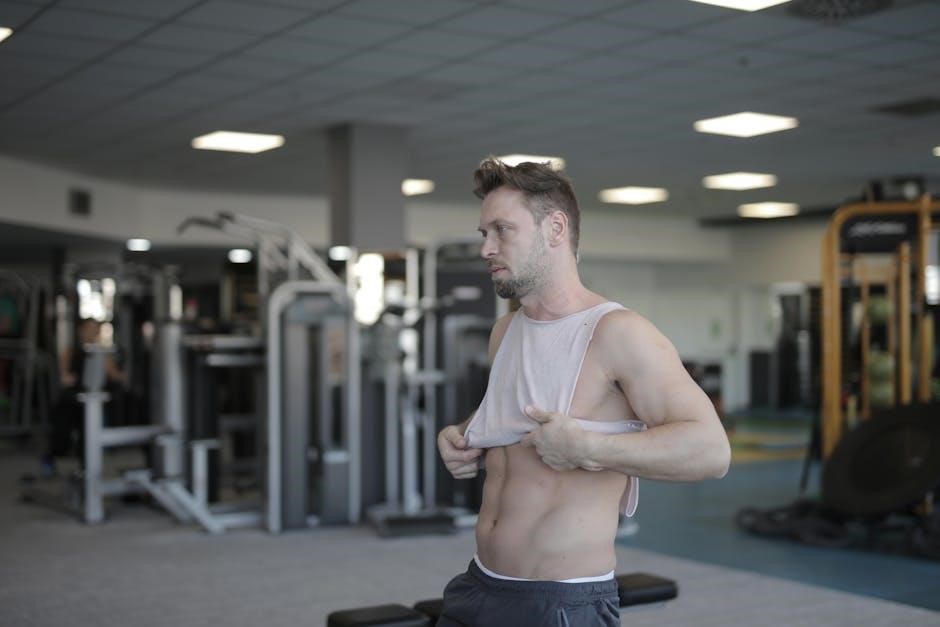
Continuous evaluation and adaptation are key to long-term success in baseball weight training․